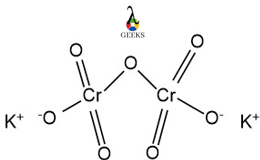A major way to detect product formation is a colour change. Let us if this reaction provides us with such example.
Hydrochloric acid can exist in both liquid and gaseous (hydrogen chloride) forms.Potassium Dichromate is a famous orange-coloured reagent in analytical chemistry, mainly in titration reactions. It serves as a good oxidising agent, producing different chromium compounds. The reaction is performed at ambient temperature.
In this article, we will see how the reaction of these two compounds happens, with their properties.
What is the product of HCl and K2Cr2O7?
HCl and K2Cr2O7 are reacted to form Potassium Chloride, Chromium(III) chloride, Chlorine gas, and Water respectively. The reaction equation is:
- K2Cr2O7 + 14 HCl = 2KCl + 2CrCl3 + 3Cl2 + 7H2O
What type of reaction is HCl + K2Cr2O7?
The reaction of HCl with K2Cr2O7 is a dissociation reaction as products dissociate with ions in the solution.
How to balance HCl and K2Cr2O7?
Following are the steps to equate the above reaction scheme:
- K2Cr2O7 + HCl = KCl + CrCl3 + Cl2 + H2O
- Step 1: As both sides should be equal in atoms, keeping stoichiometry in mind, multiply KCl with 2 to equal with the Potassium atoms of K2Cr2O7.
- K2Cr2O7 + HCl = 2KCl + CrCl3 + Cl2 + H2O
- Step 2: Multiply H2O with 7 as the product side has two hydrogen atoms.
- K2Cr2O7 + HCl = 2KCl + CrCl3 + Cl2 + 7H2O
- Step 3: Now, this makes 14 hydrogen units on the product side, which needs to be equaled on the reactant side too.
- K2Cr2O7 + 14HCl = 2KCl + CrCl3 + Cl2 + 7H2O
- Step 4: Equate the chromium atoms on both sides with 2.
- K2Cr2O7 + 14HCl = 2KCl + 2CrCl3 + 3Cl2 + 7H2O
- Step 5: To balance the chemical equation, equate the Chlorine atoms by multiplying Cl2 with 3.
- K2Cr2O7 + 14HCl = 2KCl + 2CrCl3 + 3Cl2 + 7H2O
HCl + K2Cr2O7 Titration
The titration of HCl with K2Cr2O7 will yield significant results.
Apparatus
- Graduated burette
- Conical flask
- Volumetric flask
- Burette stands
- Sample beakers
Titre and Titrant
- K2Cr2O7 is used as the titrant, the substance to be analysed.
- HCl is the titre, the concentration of which is known.
Procedure
- Potassium dichromate crystals are weighed and taken in a conical flask and dissolved well in water.
- Burette is filled with previously standardised HCl and clamped to the stand.
- Drops of HCl fall onto the contents of the flask.
- A drop of Phenolphthalein indicator is added after some time.
- At the endpoint, a very sudden colour change is noticed, which is the end of the titration.
HCl + K2Cr2O7 Net Ionic Equation
HCl + K2Cr2O7 reaction, yellowish chlorine gas is evolved while in the aqueous medium, potassium, chromium(III) and chloride ions are present.
- K2Cr2O7(s) + 14HCl(aq) = 2K+(aq) + 2Cr3+(aq) + 8Cl–(aq) + 3Cl2(g)+ 7H2O(l)
HCl + K2Cr2O7 Conjugate Pairs
If there are pair of compounds where there is one proton as chemical difference between them, those are conjugate pairs. For instance,in HCl + K2Cr2O7,
- Conjugate base of HCl= Cl–
- Conjugate base of H2O= OH–
HCl and K2Cr2O7 Intermolecular Forces
HCl shows ionic interactions in an aqueous medium. Potassium dichromate dissociates into chromate and potassium ions, showing lesser Van der Waals forces. Chromium(III) chloride dissolves well in water and is formed of a crystal lattice.

HCl + K2Cr2O7 Reaction Enthalpy
Reaction Enthalpy of HCl + K2Cr2O7 reaction is -300.4 kJ/mol. The enthalpy information is as follows:
- Enthalpy of Formation of K2Cr2O7 = -2035 kJ/mol
- Enthalpy of Formation of HCl = -92.3 kJ/mol
- Enthalpy of Formation of Cl2 = +121 kJ/mol
- Enthalpy of Formation of CrCl3= -557 kJ/mol
- Enthalpy of Formation of H2O = -285.8 kJ/mol
- Enthalpy of Formation of KCl = -438 kJ/mol
Is HCl + K2Cr2O7 a Buffer Solution?
A strong buffer solution is not formed by the reagents because it a strong acid like hydrochloric acid cannot be a part of buffer.
Is HCl + K2Cr2O7 a Complete Reaction?
HCl + K2Cr2O7 is complete as,once equilibrium is reached, products are completely formed.
Is HCl + K2Cr2O7 an Exothermic Reaction?
HCl + K2Cr2O7 reaction is exothermic with a negative enthalpy of reaction.
Is HCl + K2Cr2O7 a Redox Reaction?
The reaction of HCl and K2Cr2O7 is an actual redox reaction.
- Oxidation: Cr2O72-(aq) + 14H+(aq) + 6e → 2Cr3+(aq) + 7H2O(l)
- Chromium of chromate ion is reduced from +6 oxidation state to +3 oxidation state.
- Reduction: Cl–(aq) → 1/2Cl2(g) + e
- Chloride ion gets oxidised to chlorine gas as the oxidation state changes from -1 to 0(elemental).
- Multiplying second equation by 6 and adding both equations,
- Cr2O72-(aq) + 14H+(aq) + 6Cl–(aq) → 2Cr3+(aq) + 7H2O(l) + 3Cl2(g)
Is HCl + K2Cr2O7 a Precipitation Reaction?
HCl + K2Cr2O7 is not a precipitation reaction as one of the products is a gas and other products do not form precipitates.
Is HCl + K2Cr2O7 a Reversible Reaction?
HCl + K2Cr2O7 reaction is not reversible in nature unless we significantly alter the conditions of the reaction such as temperature and pressure.
Is HCl + K2Cr2O7 a Displacement Reaction?
The reaction of Hydrochloric acid with Potassium Dichromate is not a double displacement reaction.
Conclusion
The reaction of HCl with K2Cr2O7 forms whitish Chromium chloride, which has diverse applications in catalysis. Yellowish Chlorine gas is also observed. The solution doesn’t show significant colour change, but serves as a good dissociation reaction.

Hello….Neeloy here! I have pursued a Master’ in Chemistry and am currently a Subject Matter Expert in this community. Science and reasoning feed my curiosity and I love to express whatever I see, in my words. Quiz addict. Let’s connect at LinkedIn.